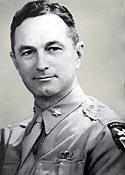William M. Miley
William Maynadier Miley | |
|---|---|
 | |
| Nickname(s) | "Bud" |
| Born | December 26, 1897 Fort MacArthur, California[1] |
| Died | September 24, 1997 (aged 99) Starkville, Mississippi |
| Place of burial | Oddfellows Cemetery |
| Allegiance | |
| Service/ | |
| Years of service | 1918–1955 |
| Rank | |
| Unit | |
| Commands held | 501st Parachute Infantry Battalion 503rd Parachute Infantry Regiment 17th Airborne Division 11th Airborne Division |
| Battles/wars | World War I World War II |
| Awards | Distinguished Service Medal (2) Silver Star Bronze Star (2) |
| Other work | Professor (Mississippi State University) |
Major General William Maynadier "Bud" Miley (26 December 1897 – 24 September 1997) was a senior United States Army officer and a professor of military science. During World War II he was one of the early pioneers of airborne warfare and was Commanding General (CG) of the 17th Airborne Division, leading it through the Battle of the Bulge and Operation Varsity.
Early life
William M. Miley was born at Fort MacArthur in California, to Sara Miley and Lt. Col. John D. Miley (for whom Fort Miley Military Reservation was named). His family had a long history of military service, with three generations before him serving in the United States Army. Two great-grandfathers, his grandfather, his father, his great-uncle, his uncle and his son all graduated from West Point.
Miley himself attended West Point, where he earned a national intercollegiate championship in gymnastics (in the tumbling, rings, and parallel bars events), and graduated in 1918. Immediately after graduation he served with the 1st Division on the Western Front, during World War I.
Following the war, Miley held a series of assignments, including as a professor of military science at what was then Mississippi State College, in Starkville, Mississippi. It was during this time that he met and married his wife, Julia Sudduth. Other assignments included serving as athletic director at West Point, and infantry assignments in Panama, the Philippines, and at Fort Sam Houston.
In 1940, Miley (then holding the rank of major) was ordered to organize and command the United States Army's first paratrooper unit, the 501st Parachute Infantry Battalion.[2]
World War II and later
After his promotion to lieutenant colonel, he was ordered to organize and command the 503rd Parachute Infantry Regiment. Shortly afterwards he was appointed Assistant Division Commander of the 82nd Airborne Division at Camp Claiborne, Louisiana, serving under Major General Matthew Ridgway.
In 1943, Miley organized the activation of the 17th Airborne Division at Camp Mackall in North Carolina. He was the sole commander of the 17th during the war, leading the Division through such actions on the Western Front as the Battle of the Bulge and Operation Varsity. The Division was deactivated in late 1945, but reactivated briefly in 1948 as a training unit.
After the war, Miley was appointed to command the 11th Airborne Division while it occupied Japan, and after its return to Fort Campbell, Kentucky. He had several later assignments, including serving as Director of the Joint Airborne Troop Board, Commander of U.S. Army Alaska, under the Alaskan Command. He also served as Chief of Staff of the former Continental Army Command (which became the United States Army Forces Command in 1973). He retired from the military in 1955, with a rank of major general.
Post-military life
Following his retirement from the army, Miley worked for Merrill Lynch, Pierce, Fenner & Beane, until his retirement in 1976, at which time he returned to Starkville, Mississippi. Miley was the second to last living division commander of World War II. He died in Starkville in September 1997 at the age of 99, three months short of turning 100. Only Major General Ralph Smith, who commanded the 27th Infantry Division during the war, would live longer, passing away in January 1998 at the age of 104.
Awards and decorations
 Parachutist Badge Parachutist Badge
|
| Army Distinguished Service Medal with oak leaf cluster | |
| Silver Star | |
| Bronze Star with oak leaf cluster |
A section of Mississippi Highway 389 (where it runs through Starkville) named the Major General William 'Bud' Miley Highway.[3]
References
- ^ Bio of Maj. Gen. Miley. Retrieved on December 29, 2009.
- ^ U.S. Army Infantry Homepage
- ^ SB2888 (As Sent to Governor) - 1998 Regular Session
External links
- 1897 births
- 1997 deaths
- American military personnel of World War II
- Recipients of the Distinguished Service Medal (United States)
- Recipients of the Silver Star
- Recipients of the Bronze Star Medal
- United States Military Academy alumni
- Military personnel from California
- People from the Greater Los Angeles Area
- Air Corps Tactical School alumni
- American military personnel of World War I
